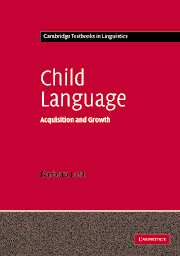Book contents
- Frontmatter
- Contents
- List of figures
- List of tables
- Preface
- Acknowledgements
- 1 The Growth of language
- 2 What is acquired?
- 3 What is the problem of language acquisition?
- 4 How we can construct a theory of language acquisition
- 5 Brain and language development
- 6 The nature of nurture
- 7 How can we tell what children know? Methods for the study of language acquisition
- 8 The acquisition of phonology
- 9 The acquisition of syntax
- 10 The acquisition of semantics
- 11 On the nature of language growth
- 12 Conclusions: toward an integrated theory of language acquisition
- Appendices
- 1 Developmental milestones in motor and language development (adapted from Lenneberg 1967)
- 2a Developmental milestones in infant speech perception
- 2b Examples of sound distinctions perceived by infants
- 3 Developmental milestones in infant speech production
- 4 Developmental milestones in infant syntax: perception
- 5 Developmental milestones in infant syntax: production
- 6 Developmental milestones in infant semantics
- 7 Abbreviations and notations
- Glossary
- References
- Author index
- Subject index
2 - What is acquired?
Published online by Cambridge University Press: 05 June 2012
- Frontmatter
- Contents
- List of figures
- List of tables
- Preface
- Acknowledgements
- 1 The Growth of language
- 2 What is acquired?
- 3 What is the problem of language acquisition?
- 4 How we can construct a theory of language acquisition
- 5 Brain and language development
- 6 The nature of nurture
- 7 How can we tell what children know? Methods for the study of language acquisition
- 8 The acquisition of phonology
- 9 The acquisition of syntax
- 10 The acquisition of semantics
- 11 On the nature of language growth
- 12 Conclusions: toward an integrated theory of language acquisition
- Appendices
- 1 Developmental milestones in motor and language development (adapted from Lenneberg 1967)
- 2a Developmental milestones in infant speech perception
- 2b Examples of sound distinctions perceived by infants
- 3 Developmental milestones in infant speech production
- 4 Developmental milestones in infant syntax: perception
- 5 Developmental milestones in infant syntax: production
- 6 Developmental milestones in infant semantics
- 7 Abbreviations and notations
- Glossary
- References
- Author index
- Subject index
Summary
What is language?
In this chapter, we, like children, seek “… the discovery of the place of human language in the universe.”
(Hockett 1977, 163)It is impossible to study the acquisition of language scientifically unless we address the question, “what is language?,” i.e., “what is acquired?” (2.1 and 2.2). We sketch an overview of the linguistic computation children must acquire when they acquire a language, laying down a number of fundamental concepts and terms (2.3). We sketch the basic design of human language knowledge and the basic architecture of the human Language Faculty (2.4). We provide a framework for investigation into the nature of language acquisition. These foundations allow us to form the “essential questions of language acquisition” (2.5).
Attempting to define language
Language is first and foremost symbolic. Sounds, words and sentences represent and capture an infinity of possible meanings and intentions. We can produce, understand and think of an infinity of possible statements, questions, commands or exclamations. These may concern the future, the past, what has occurred and what has not, what is possible or impossible. Through language, we can tell the truth or lie, regret or hope. We can deploy an infinity of demands, requests, contradictions, ranging from poetry to propaganda. The next sentence we say or understand is almost certainly going to be one we have never heard or said before, suggesting that this symbolic capacity of language is in a real sense limitless.
- Type
- Chapter
- Information
- Child LanguageAcquisition and Growth, pp. 9 - 27Publisher: Cambridge University PressPrint publication year: 2006

